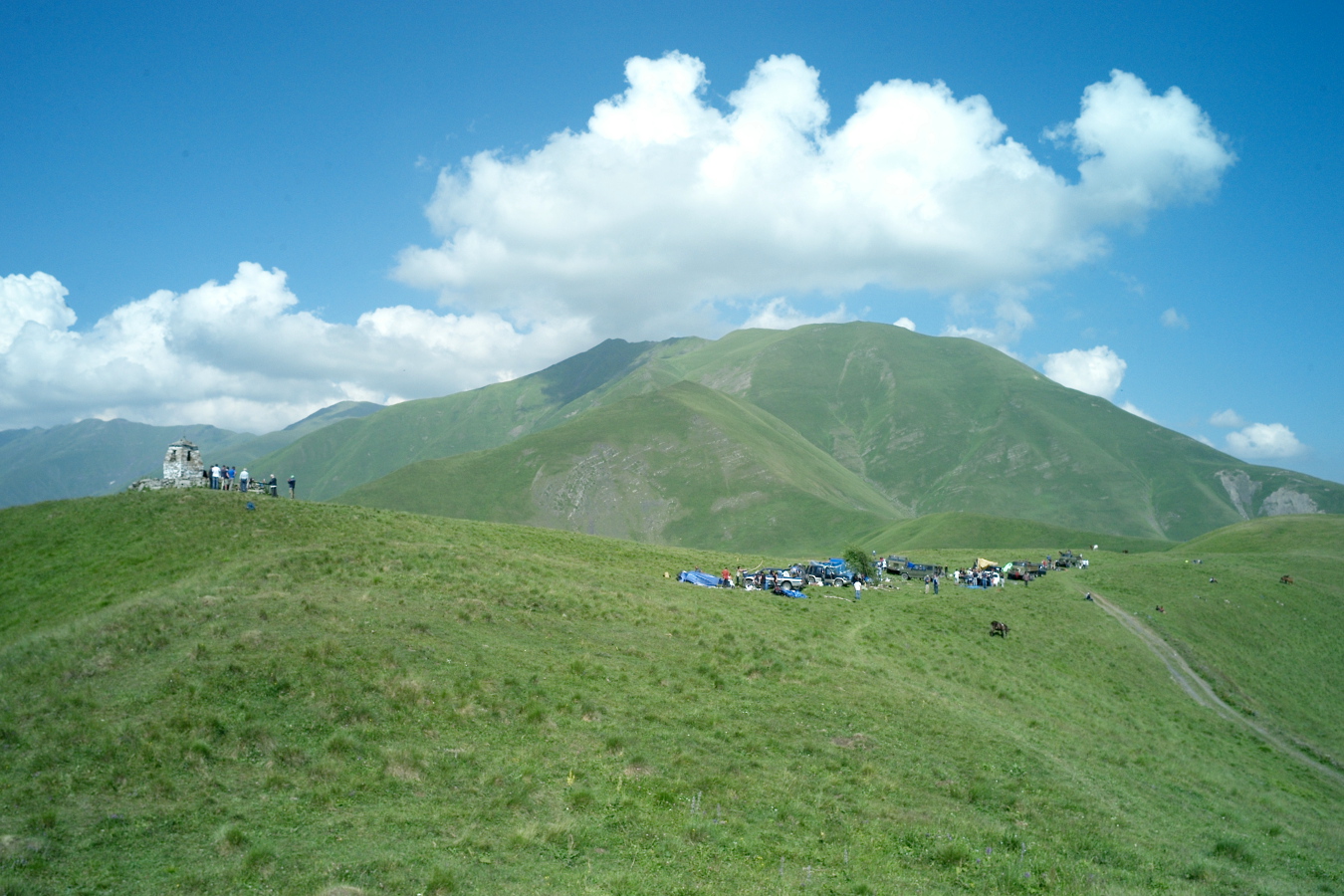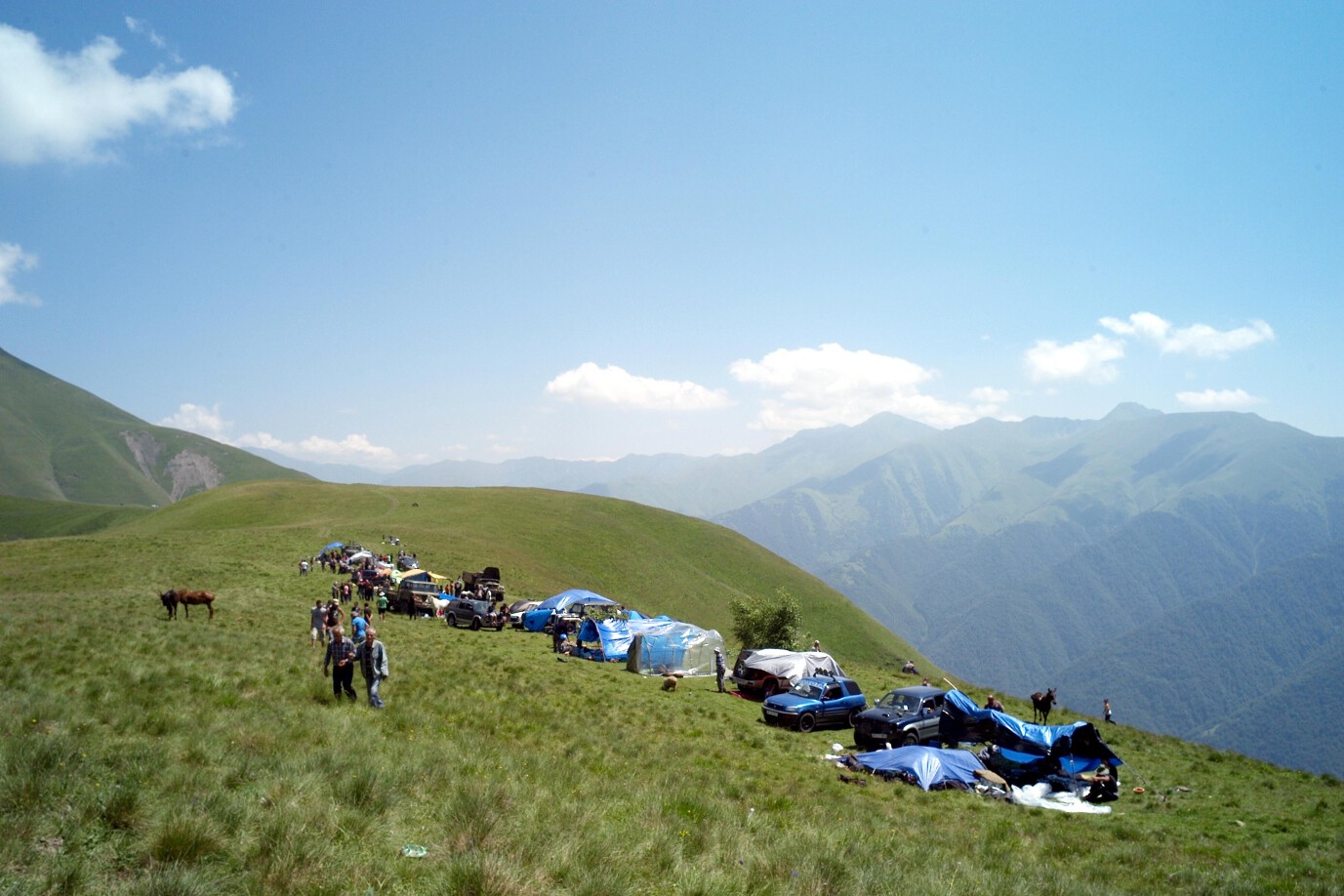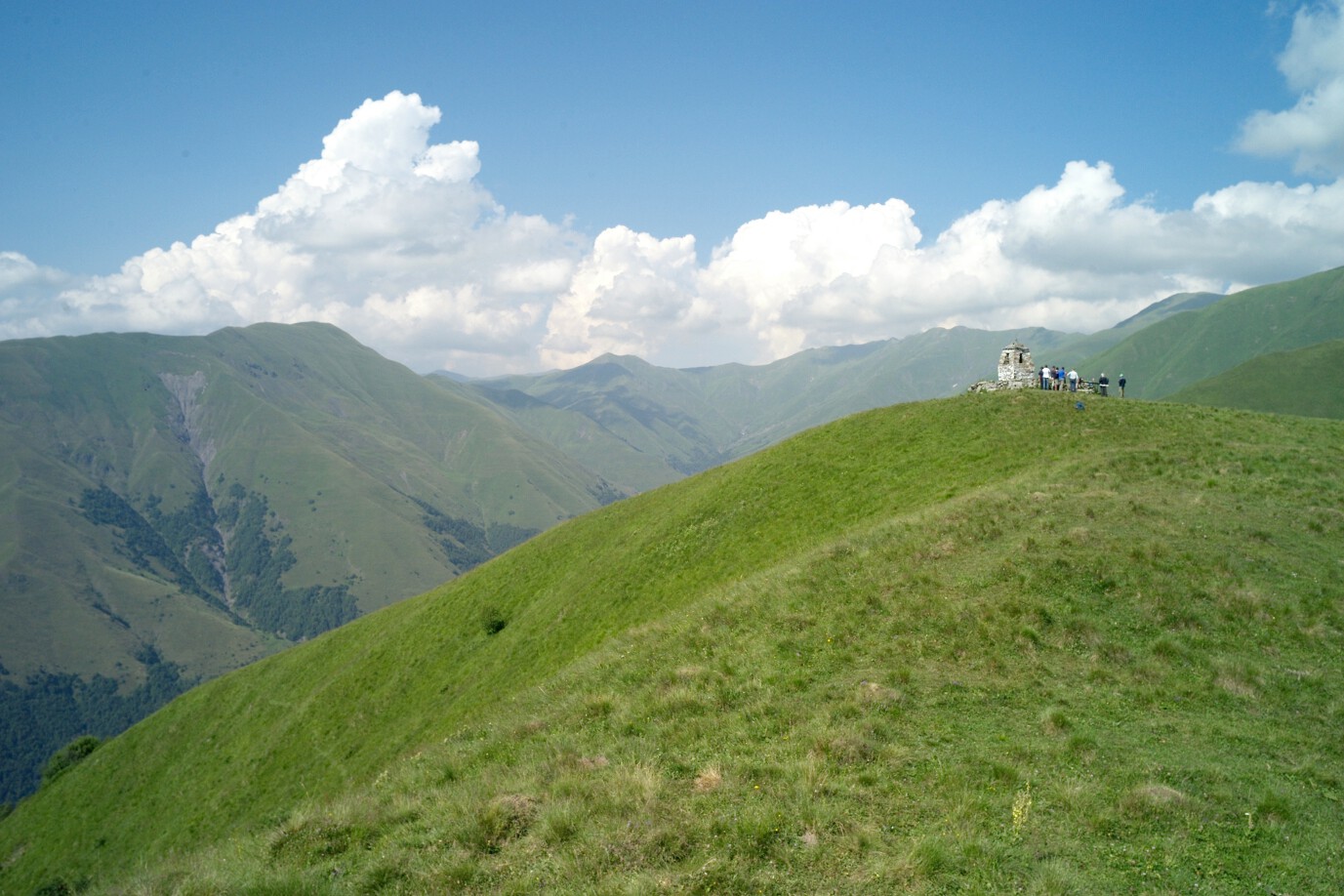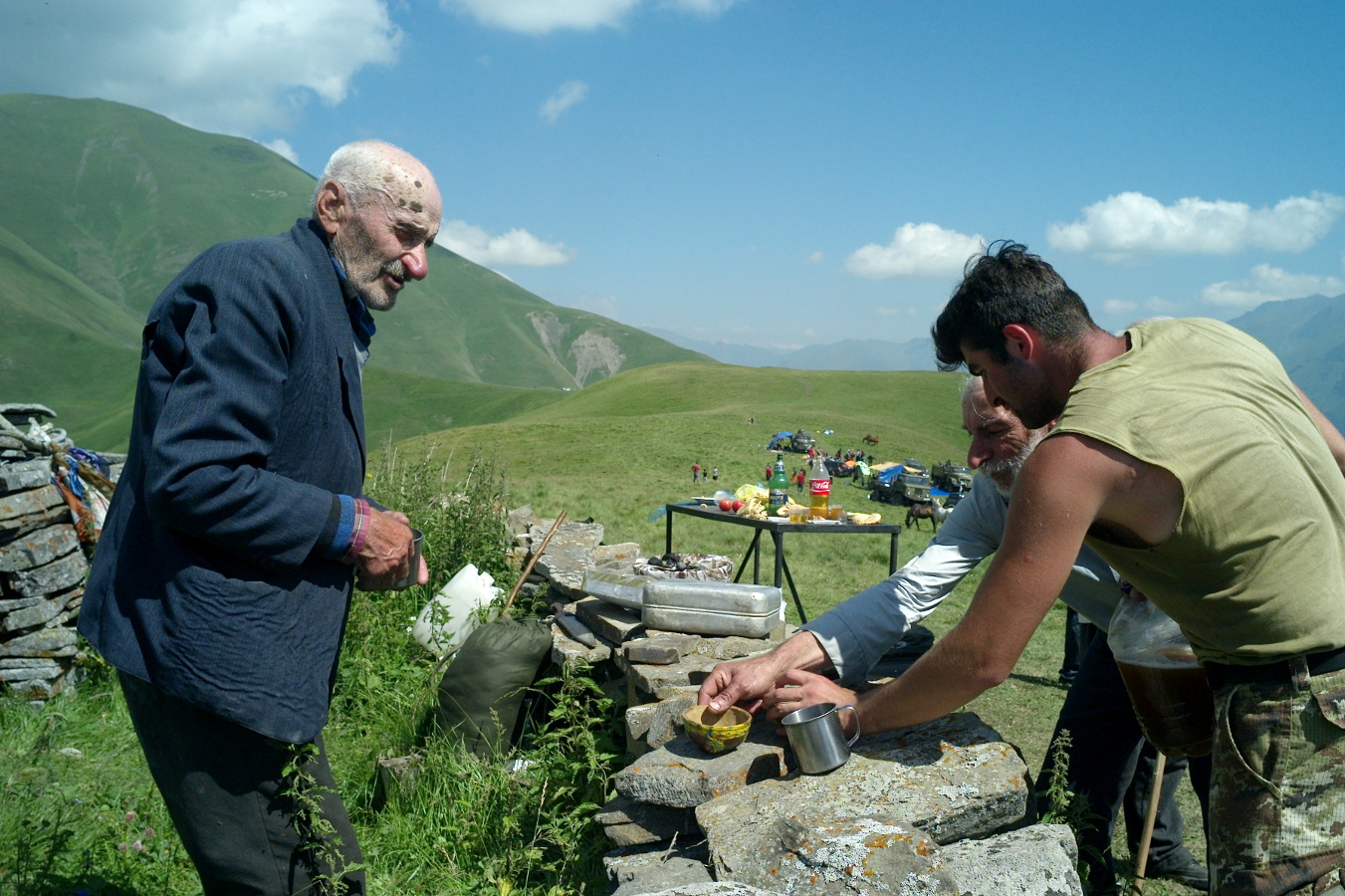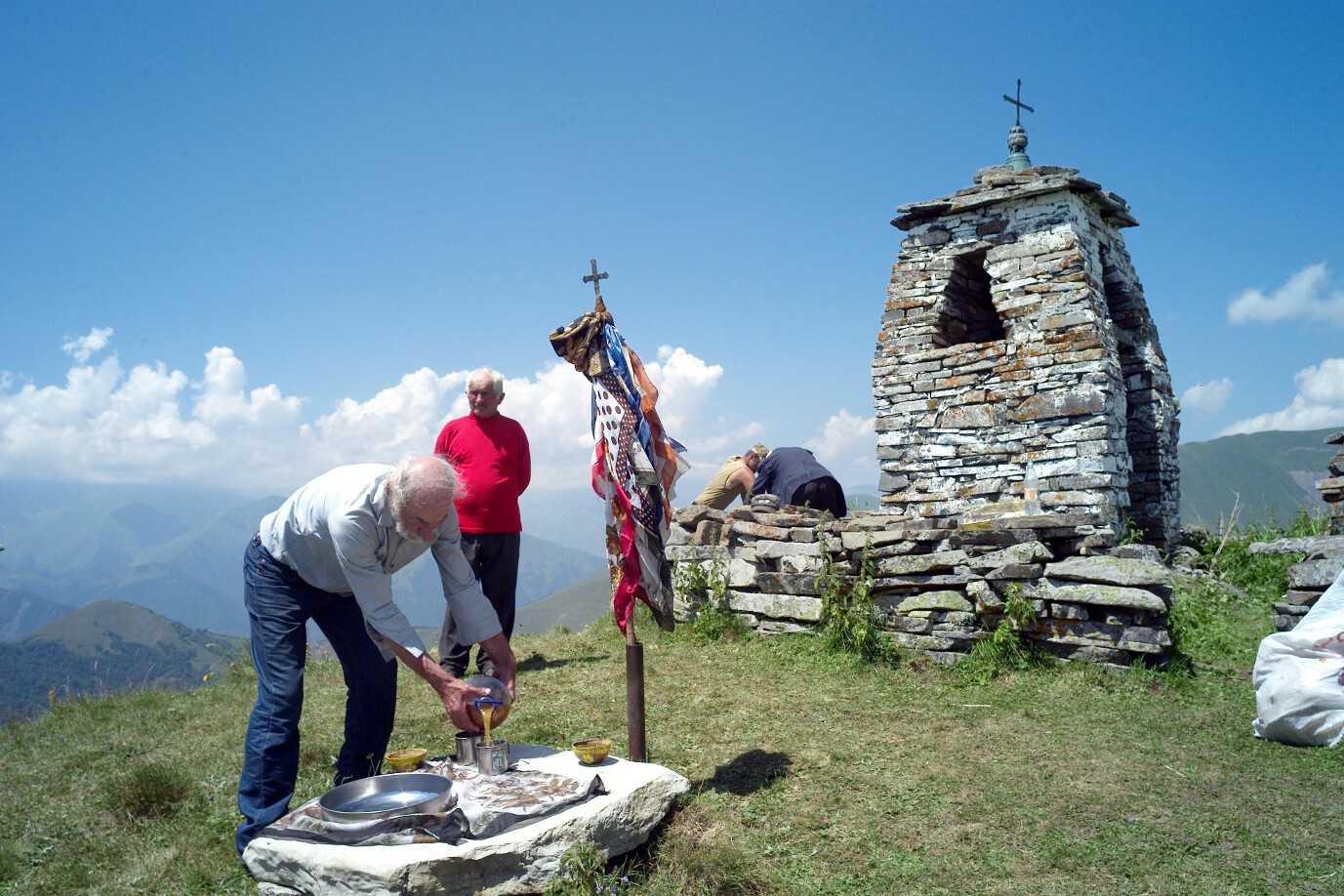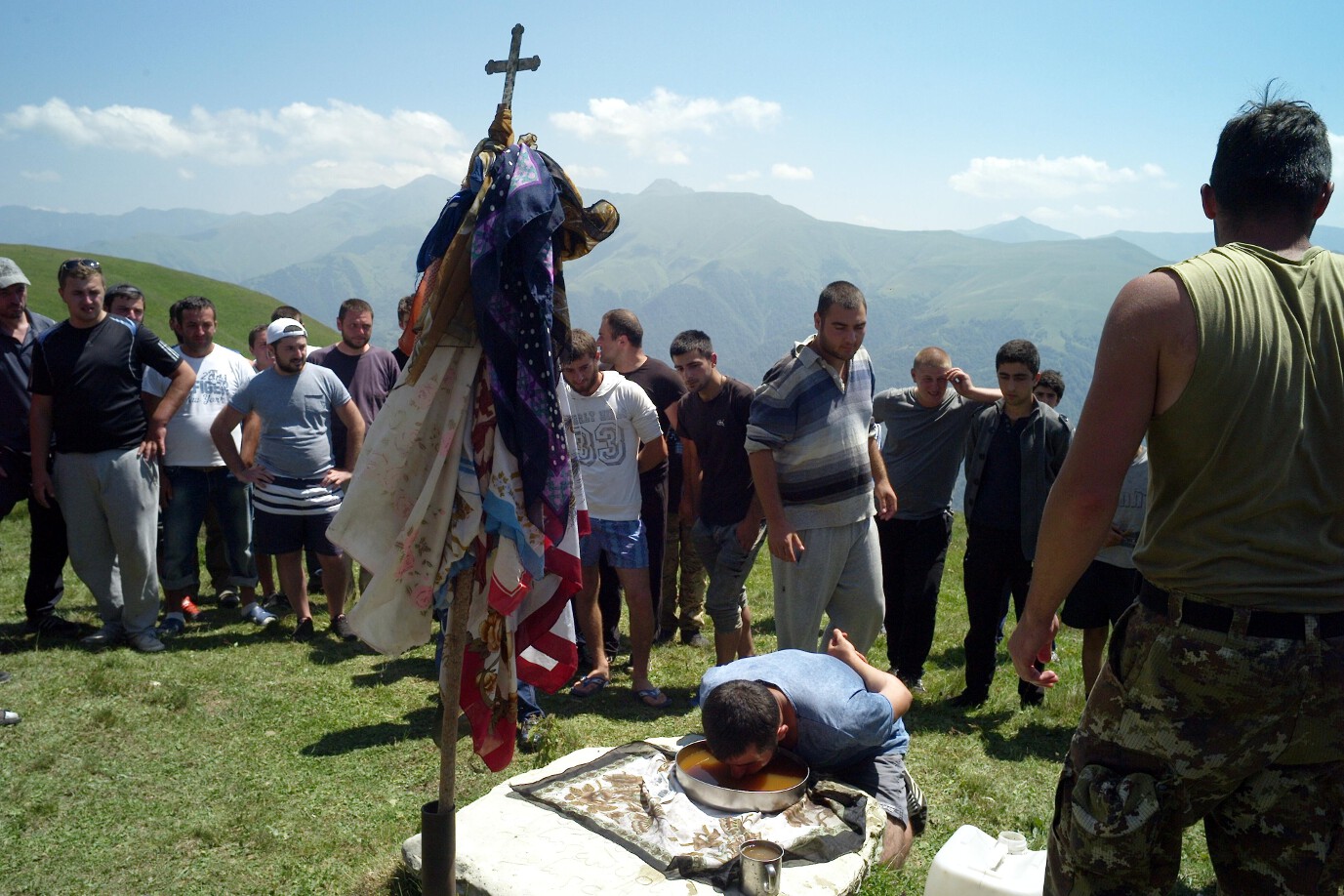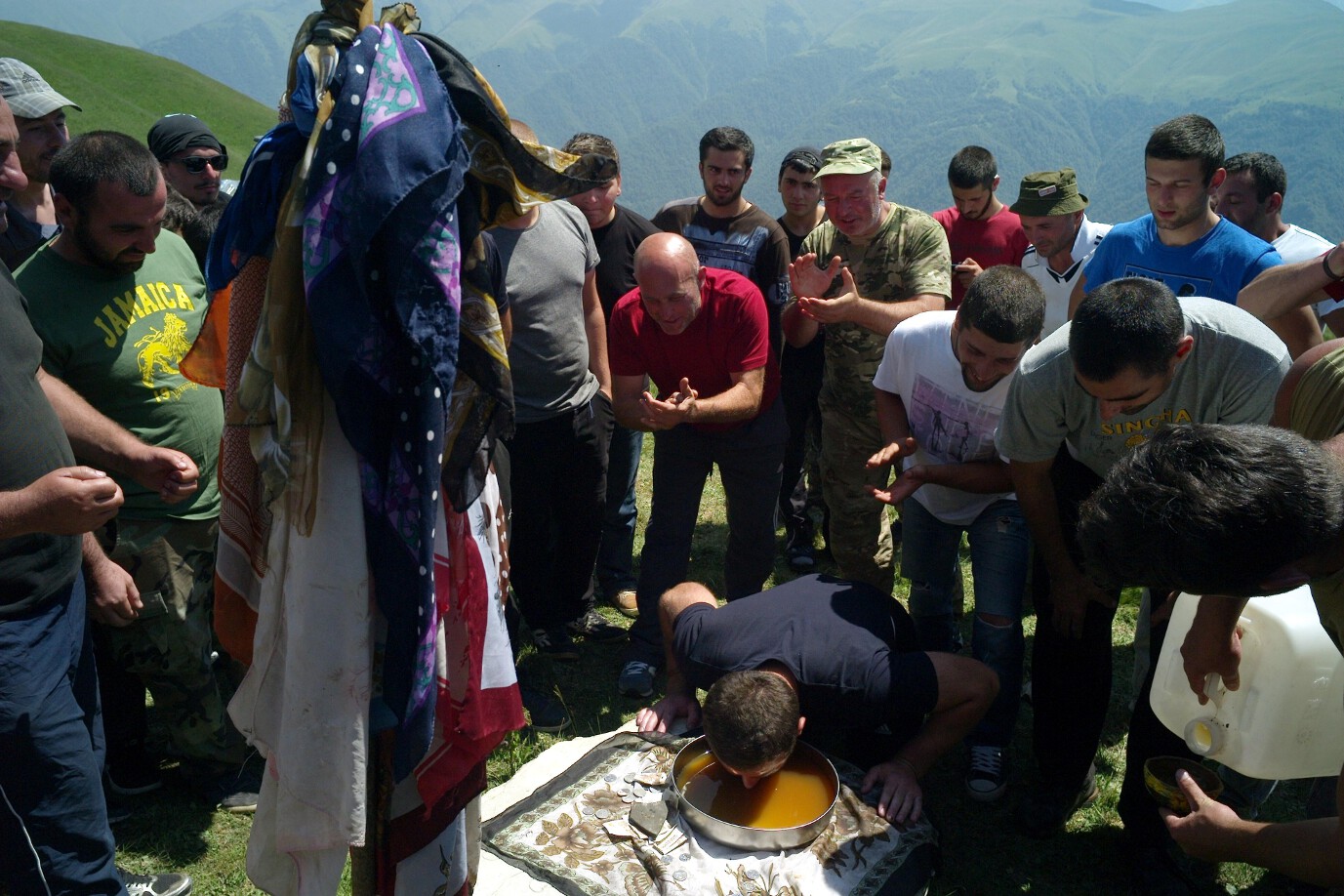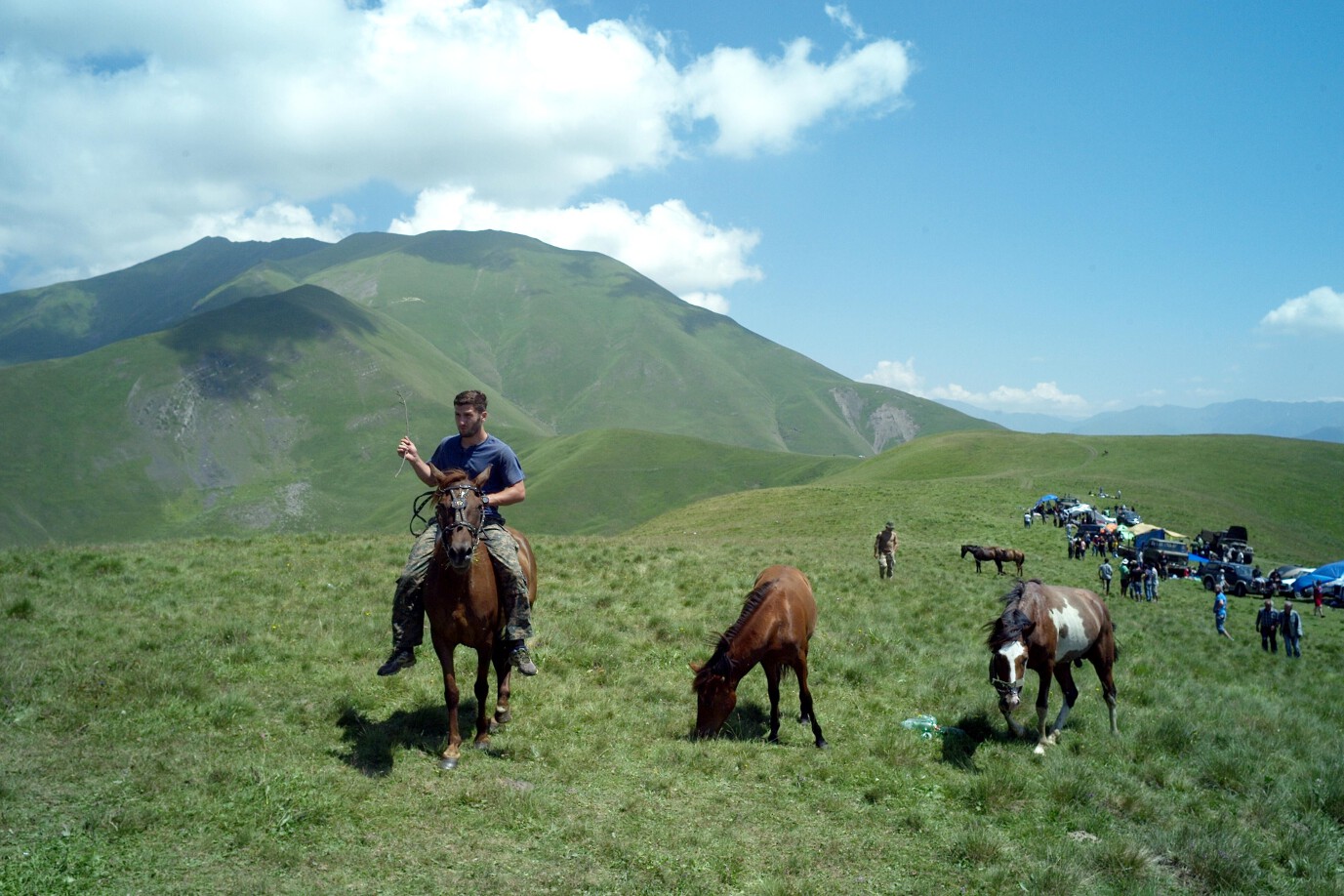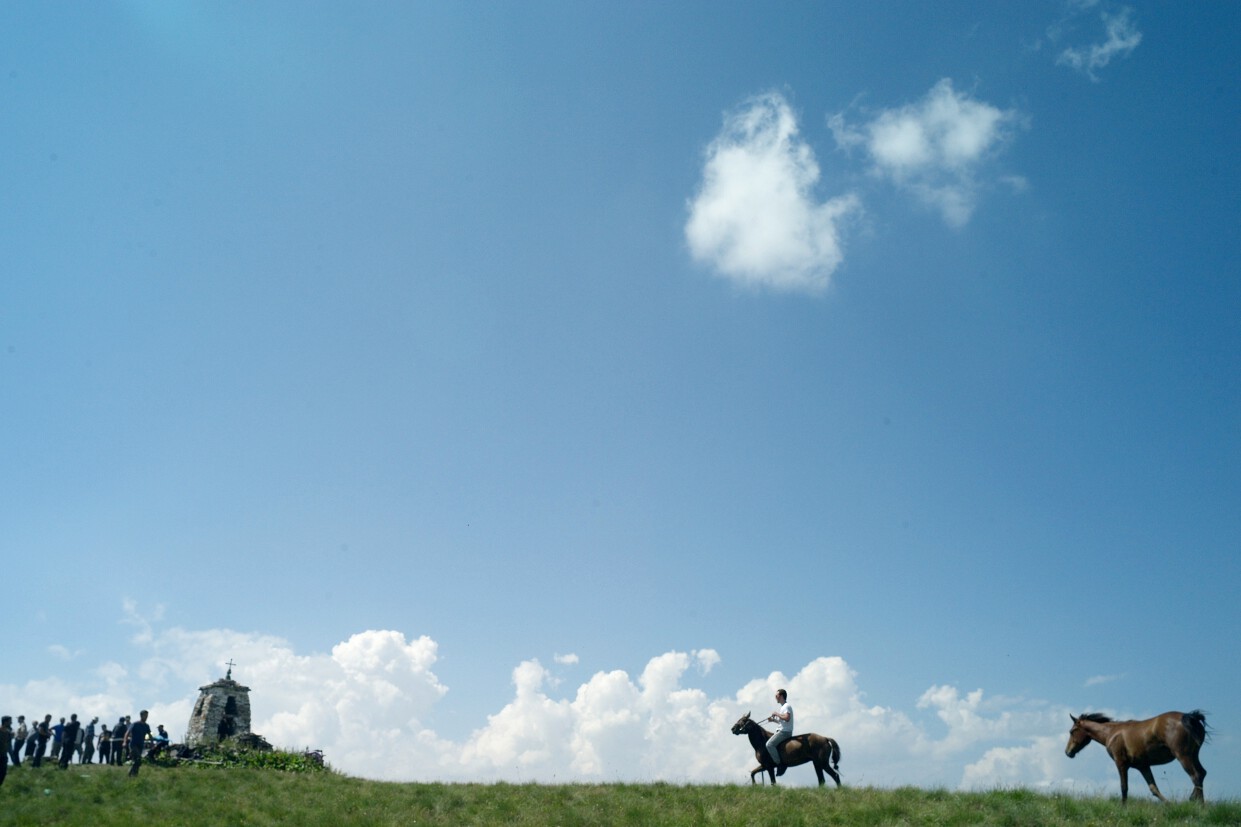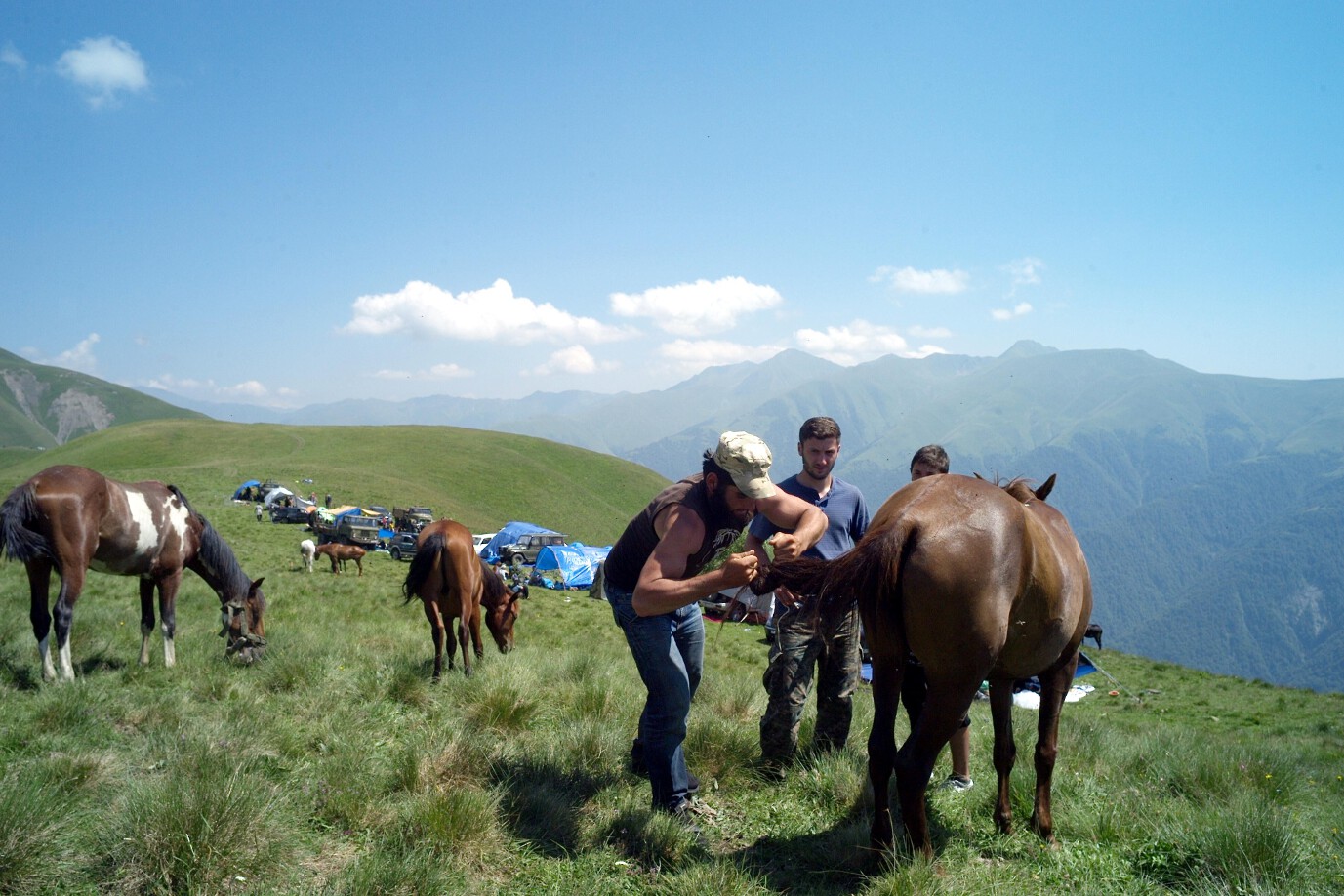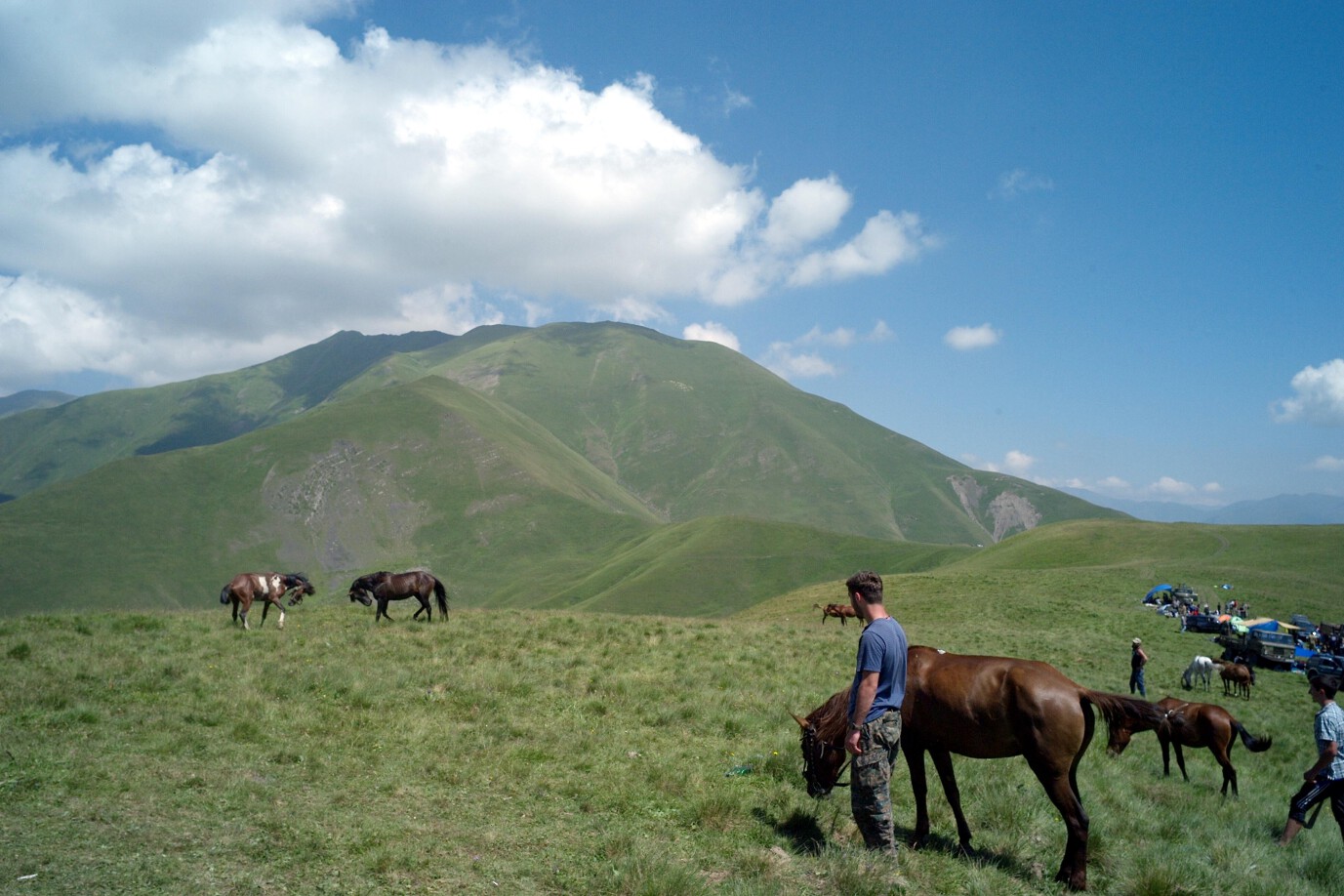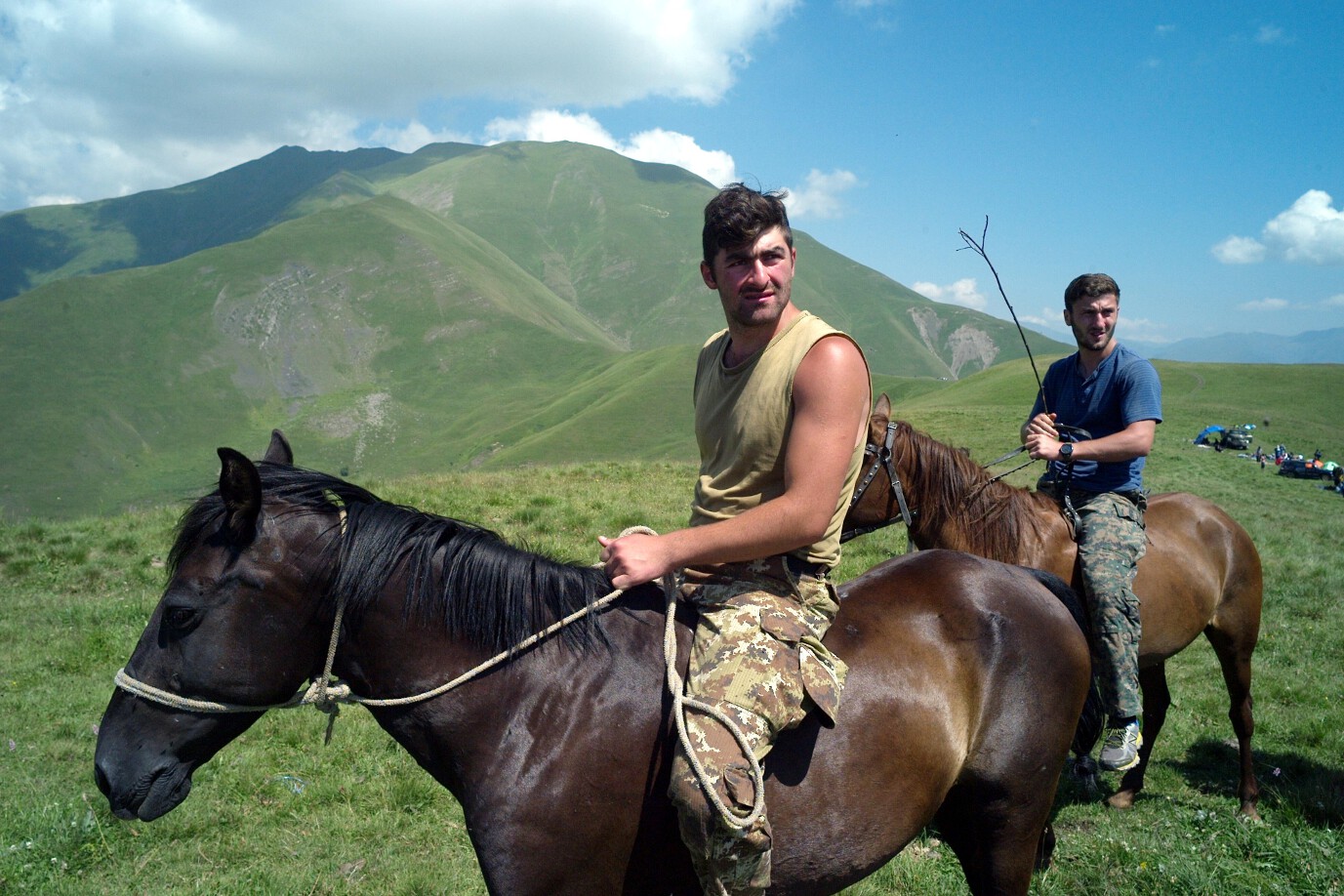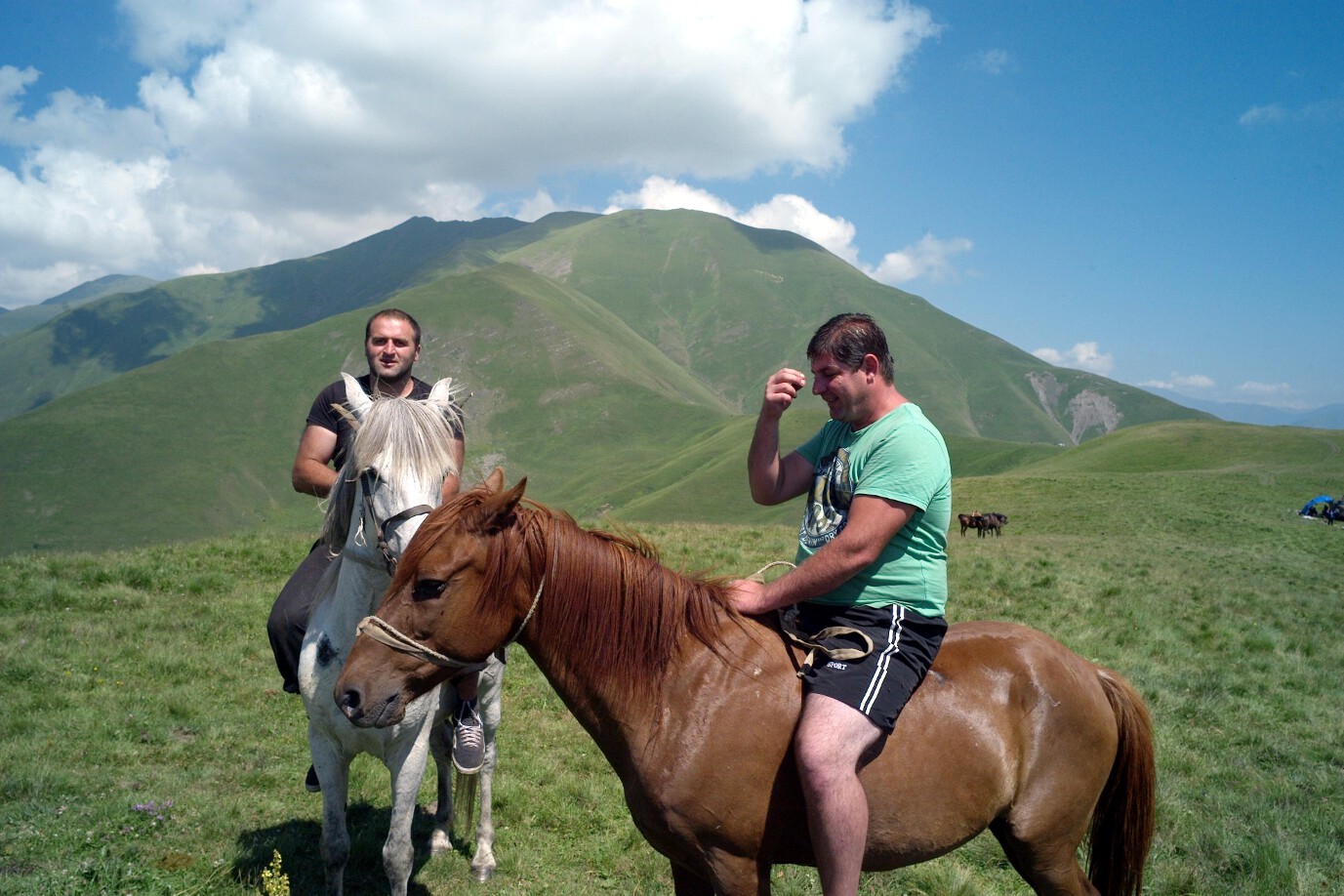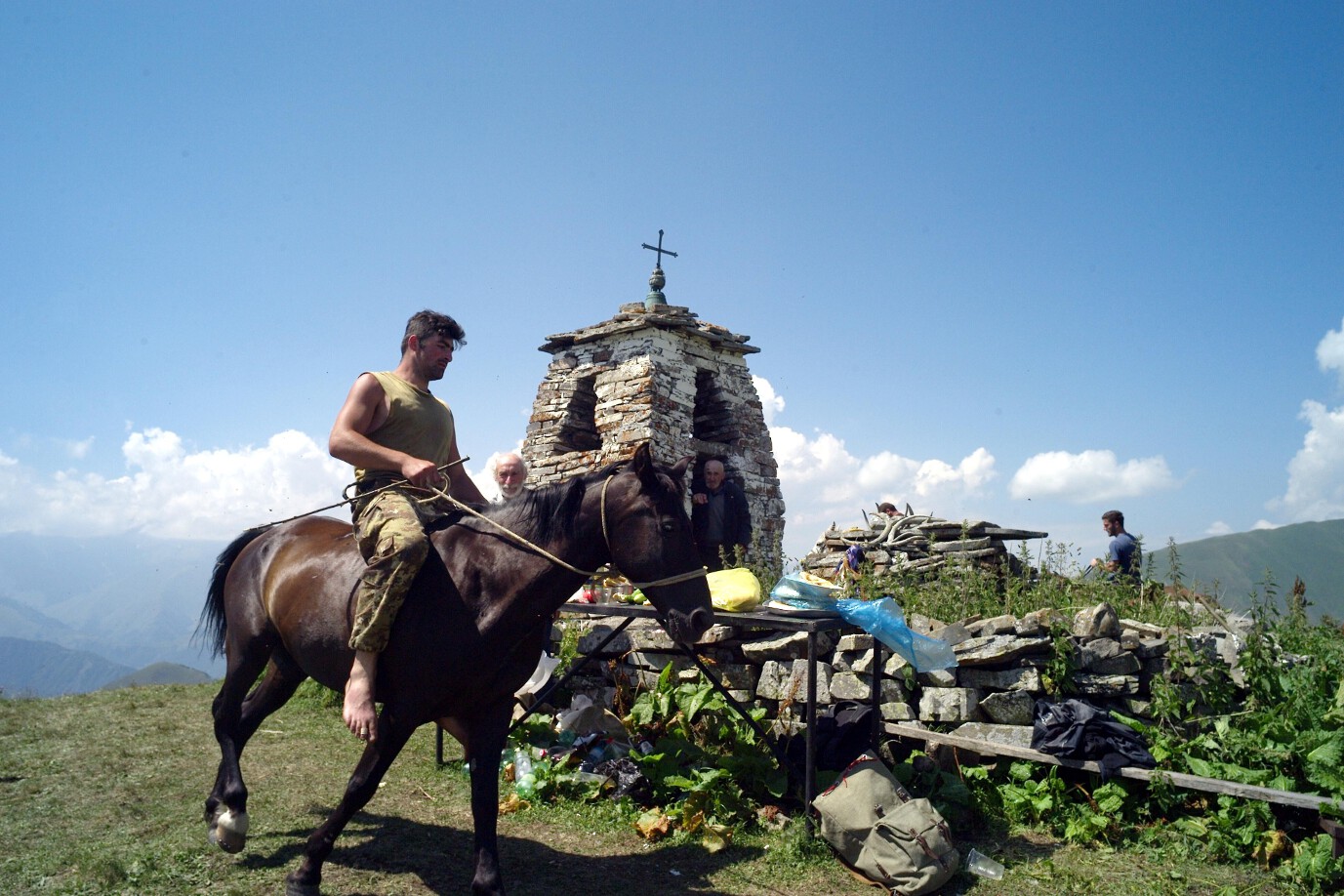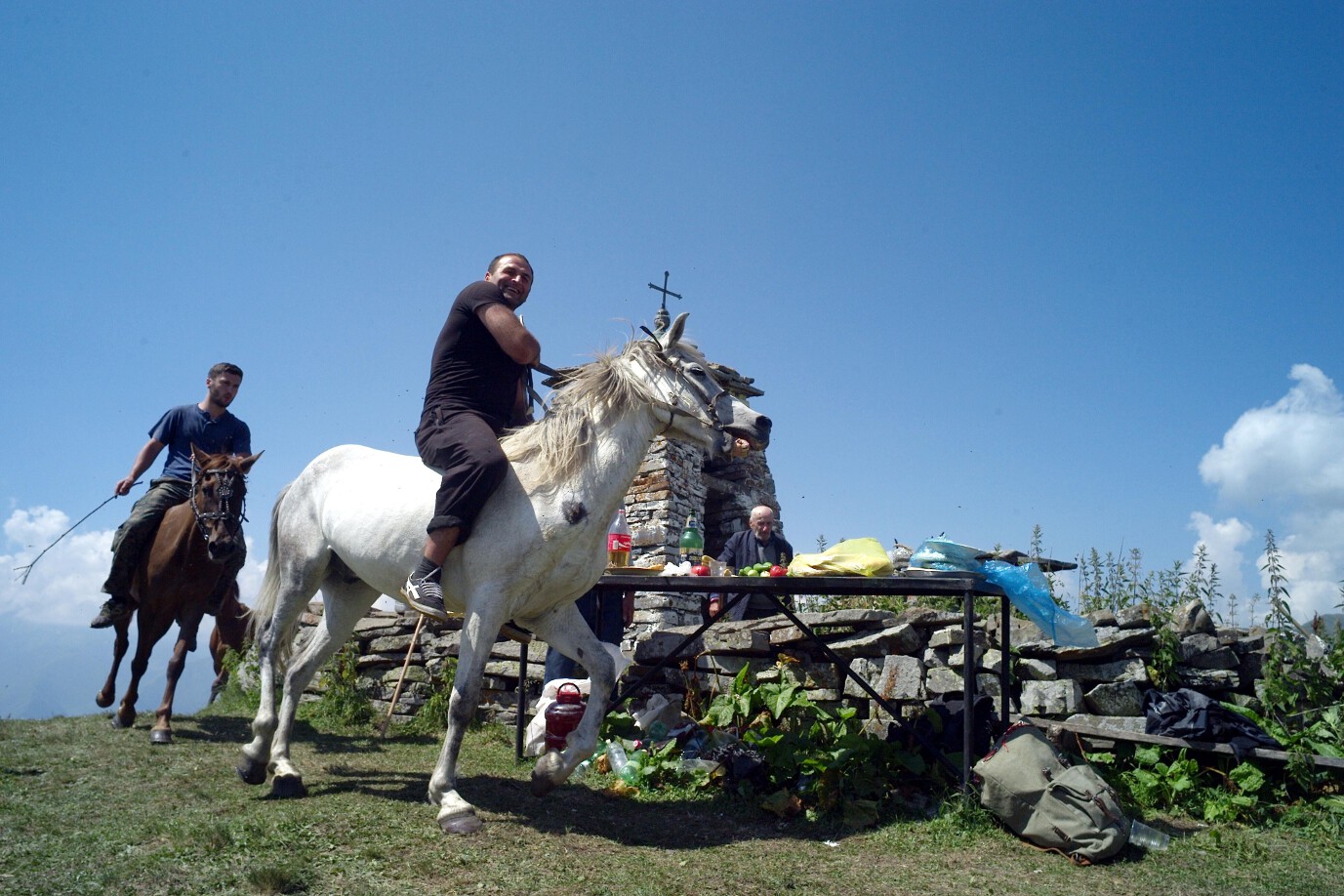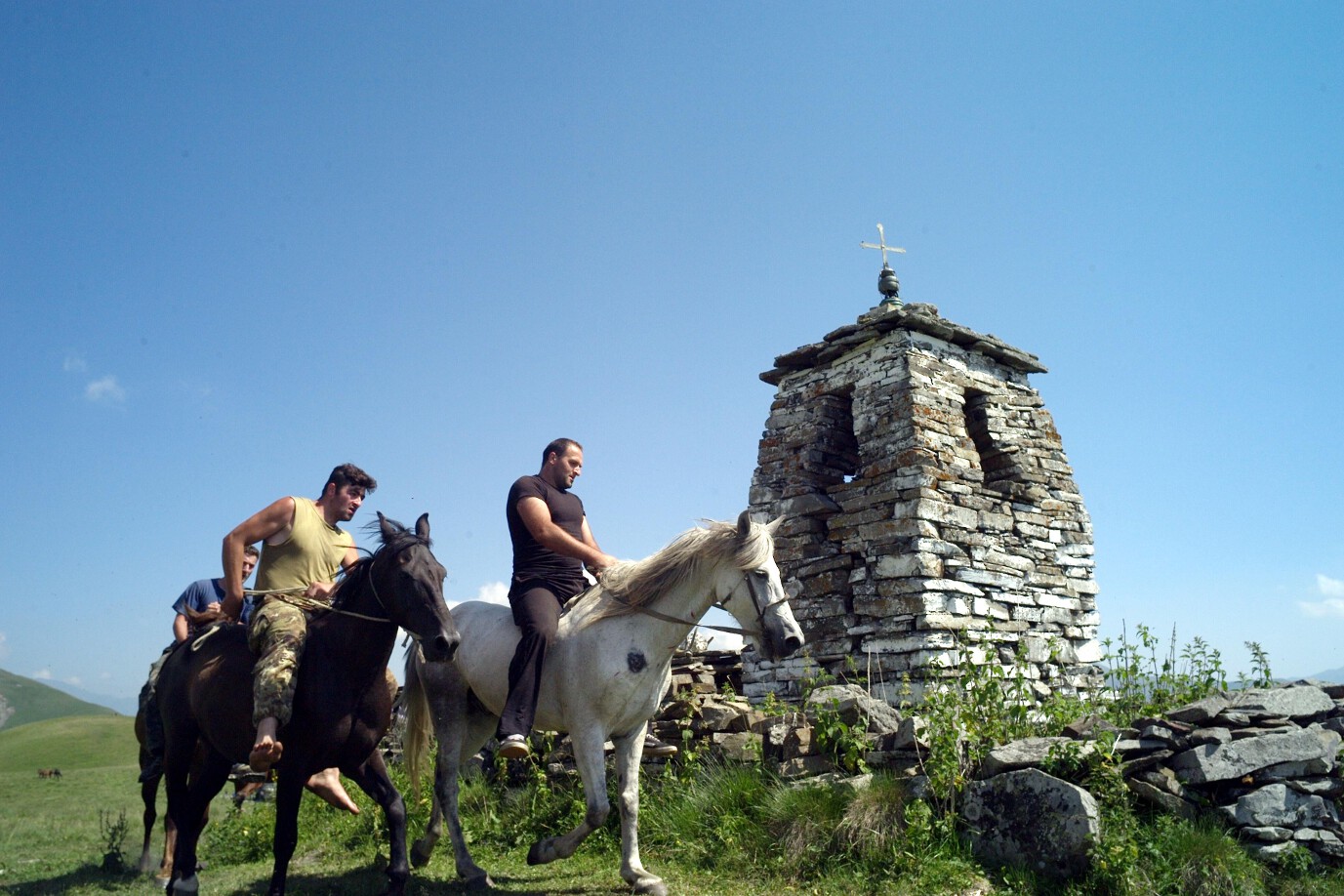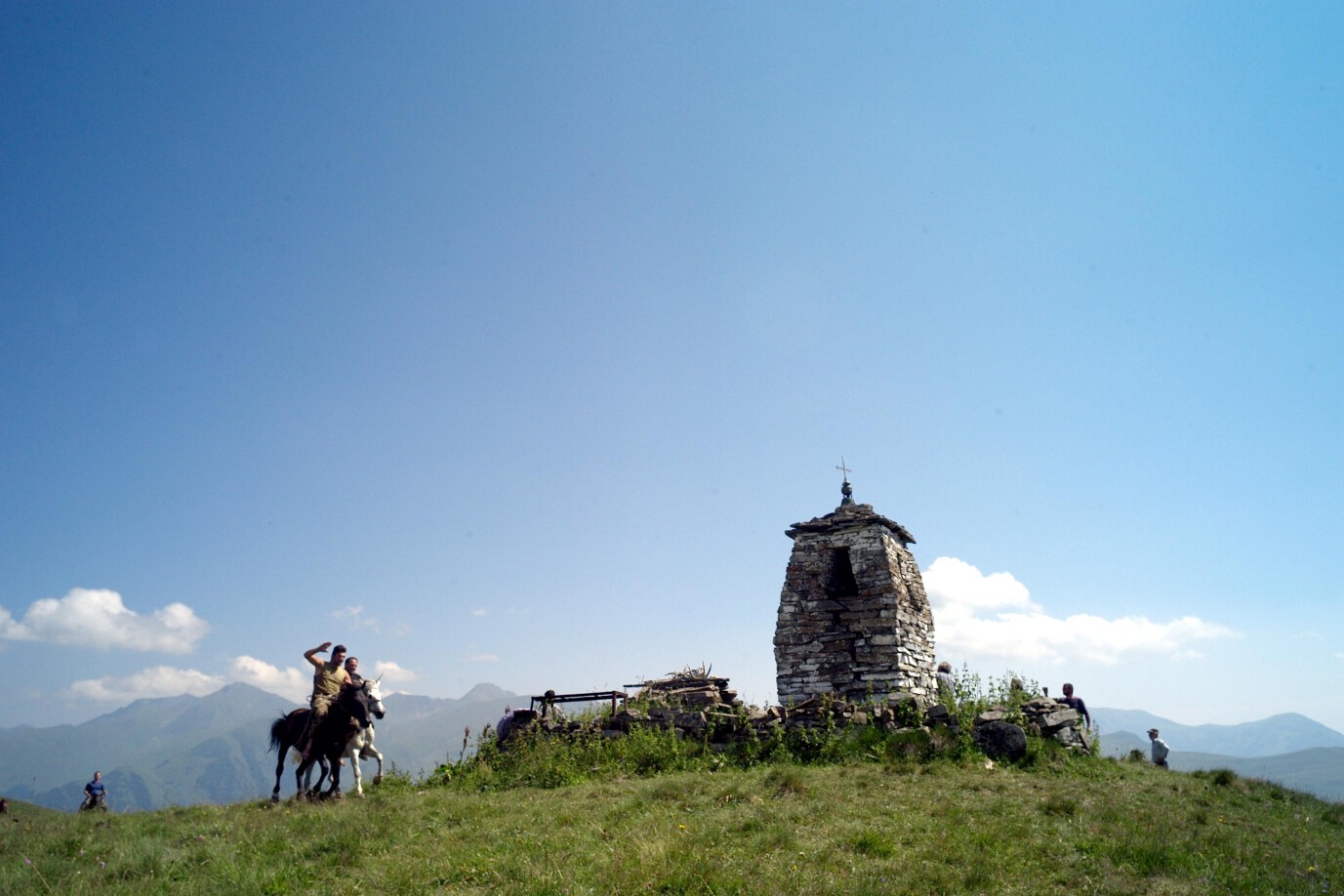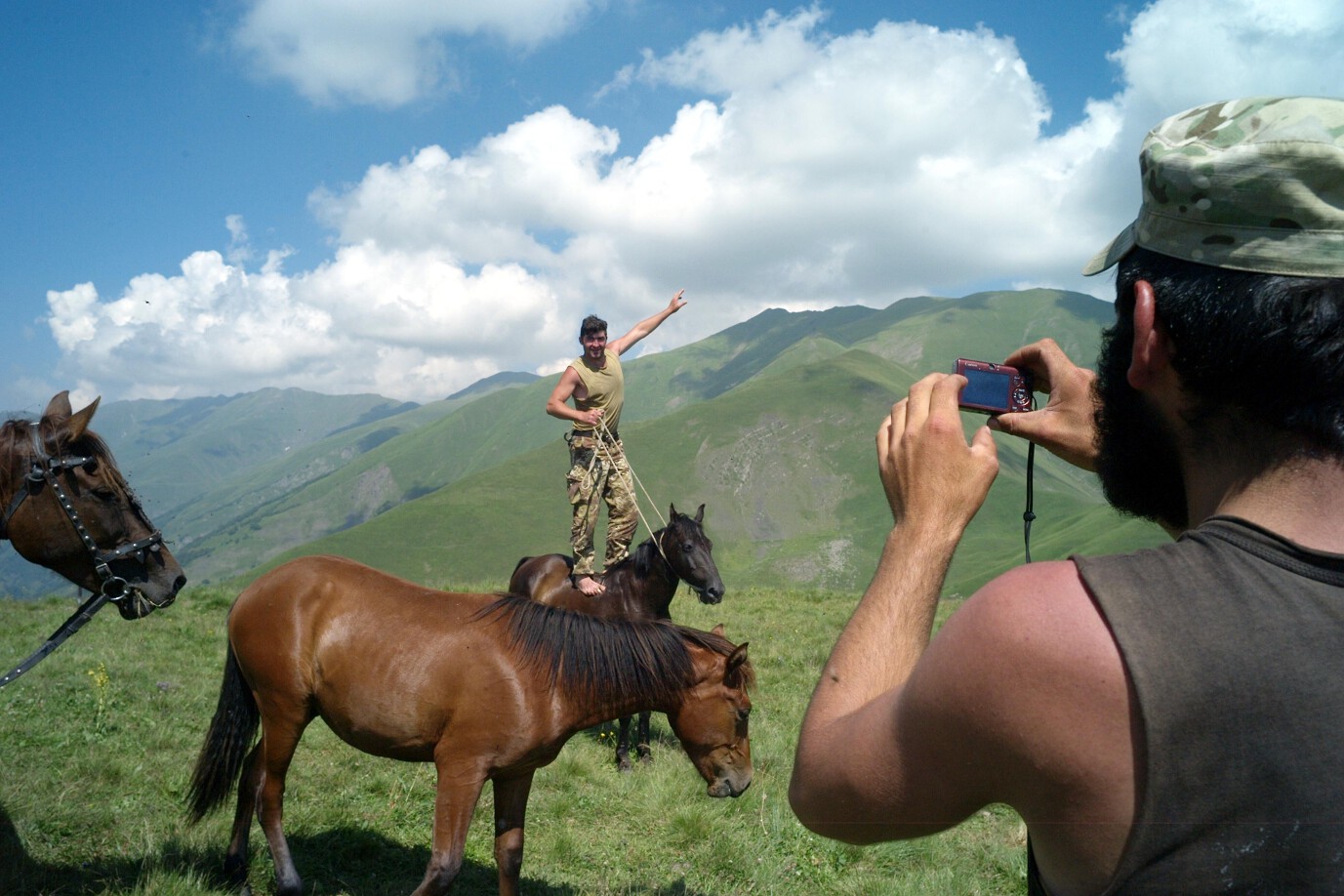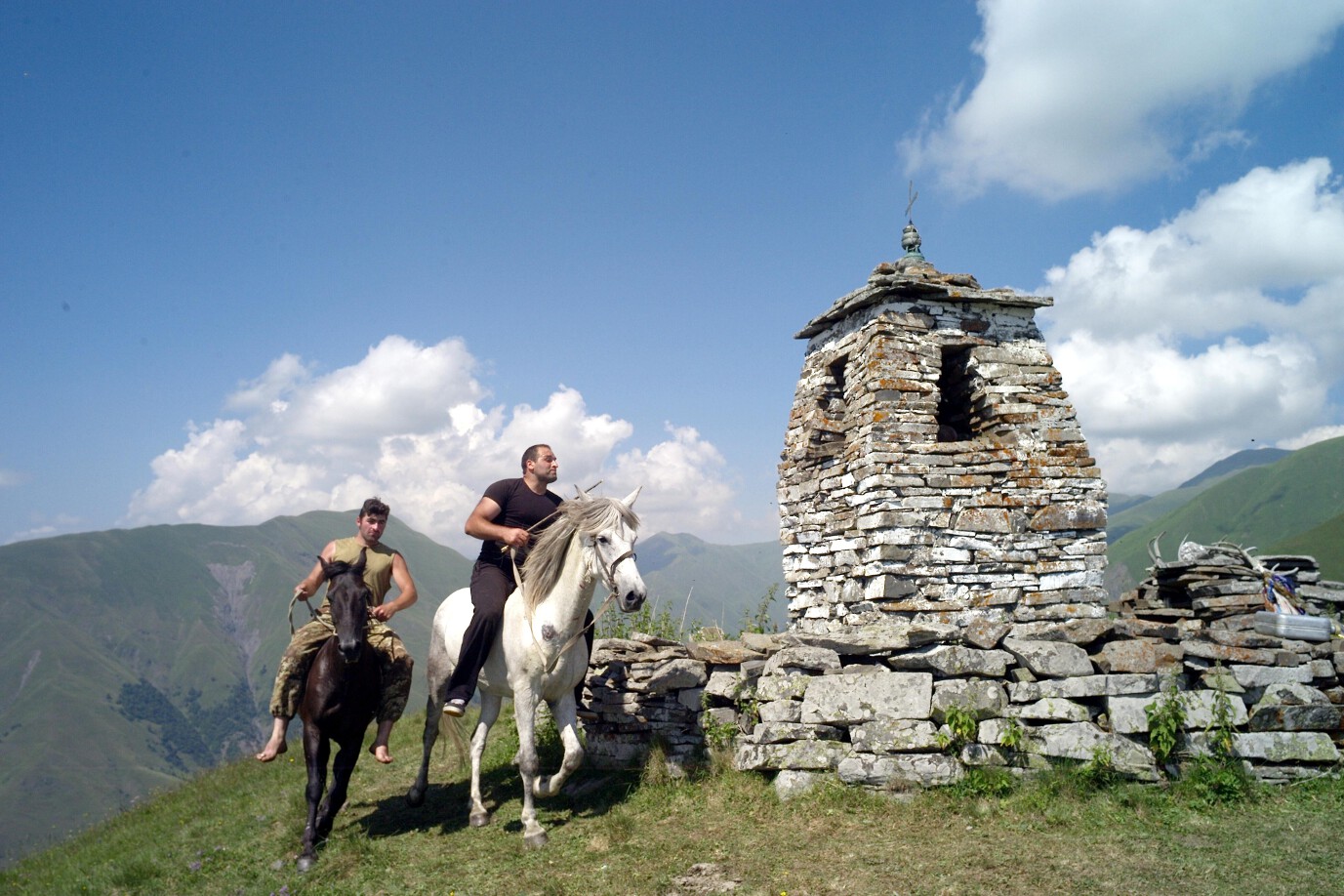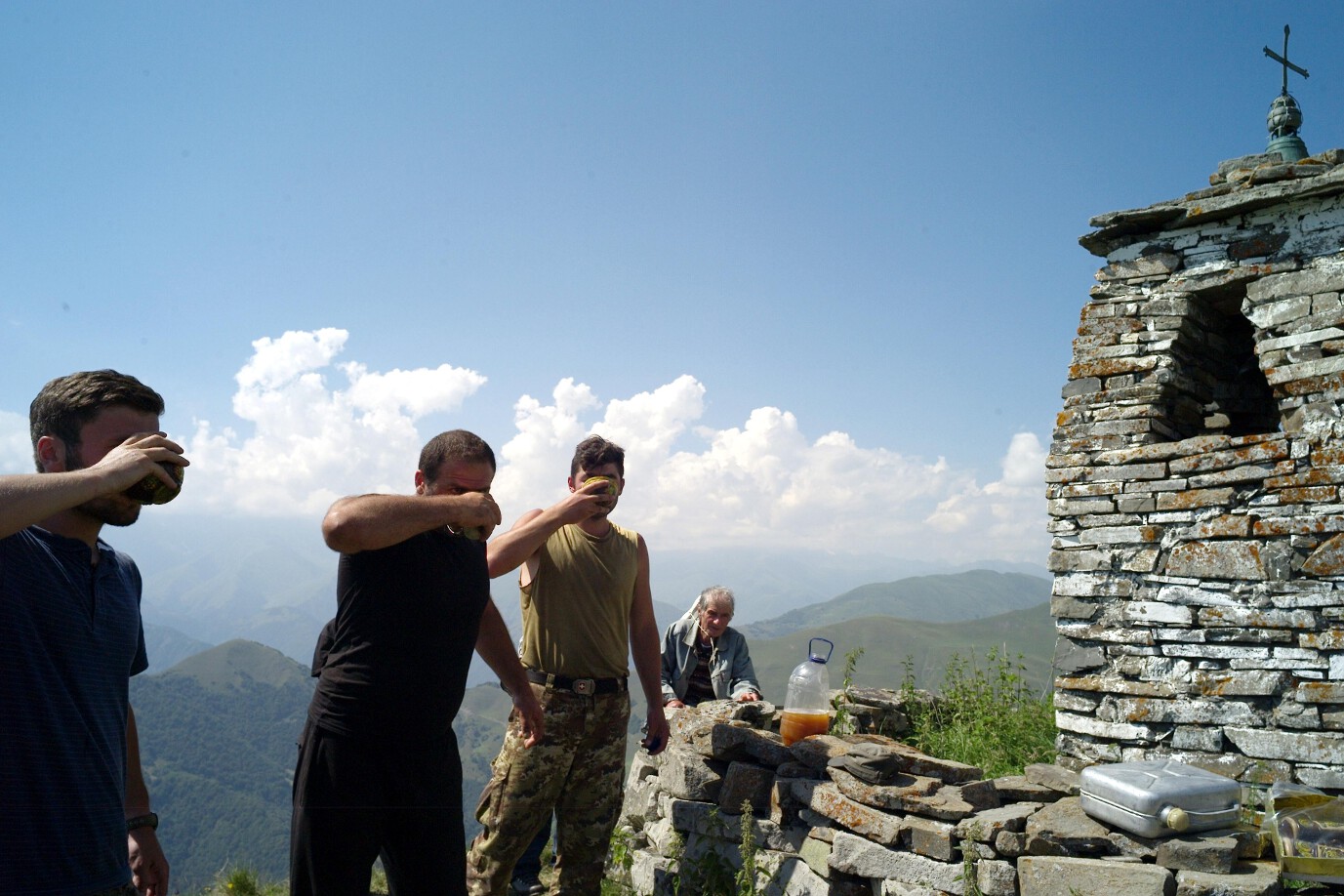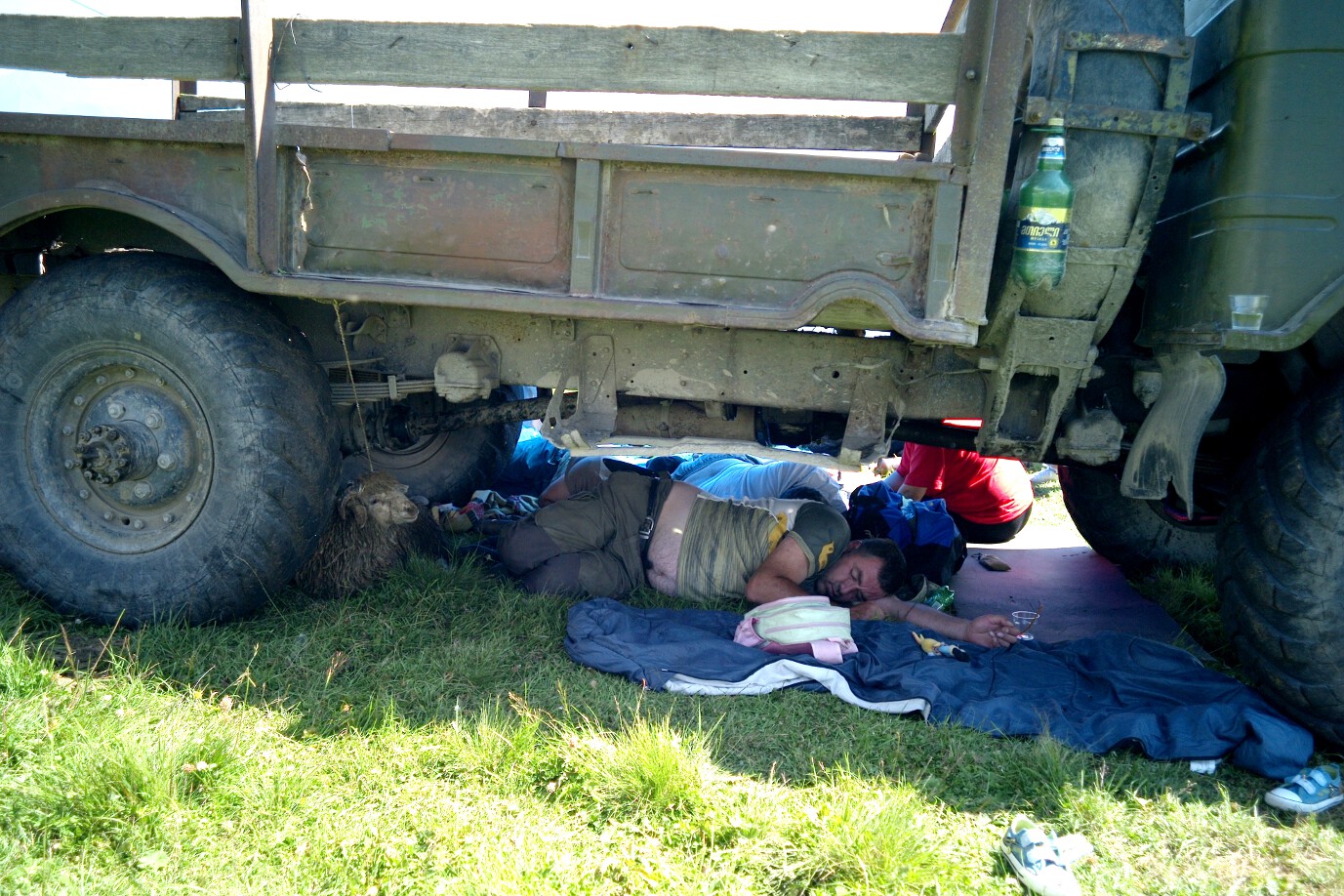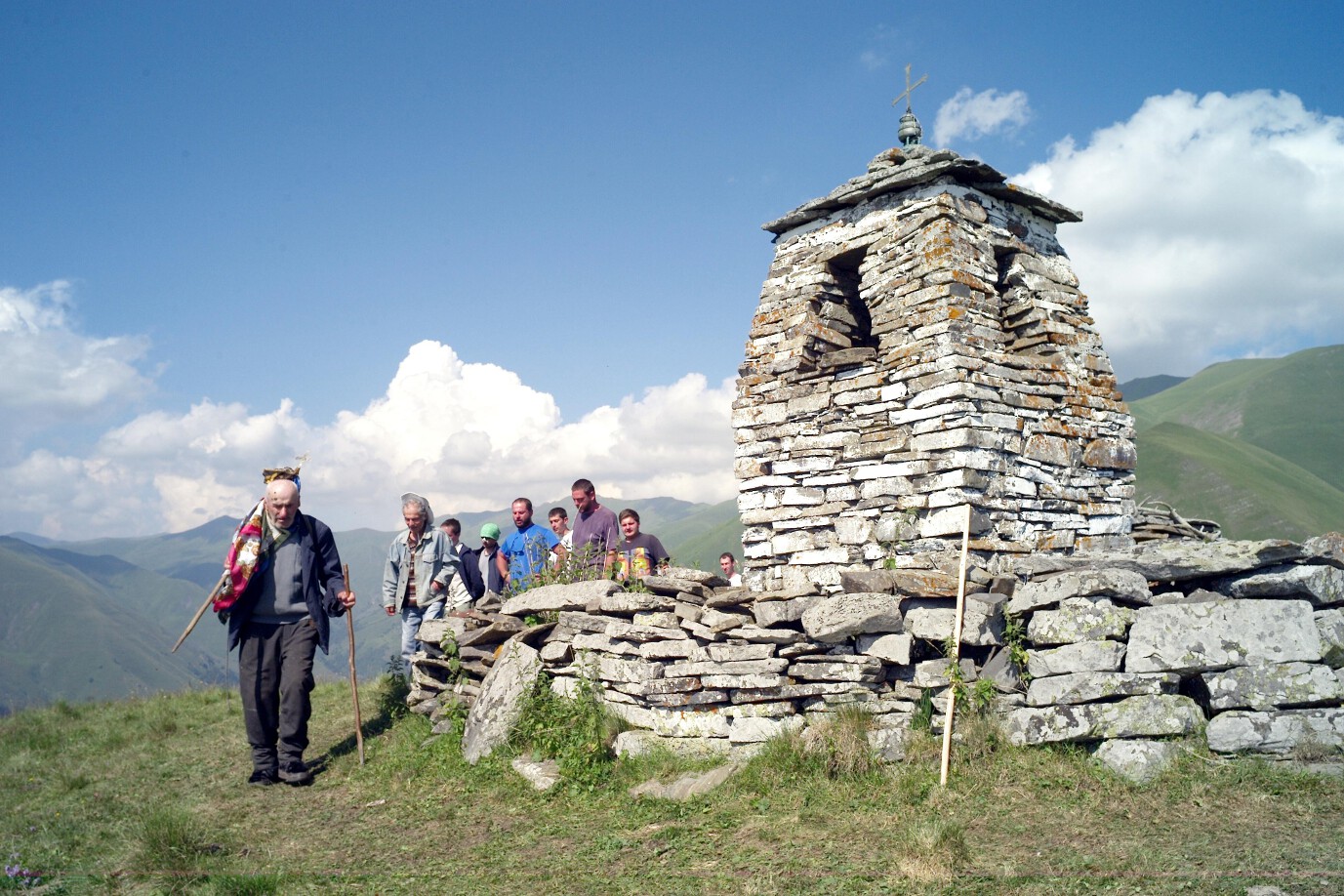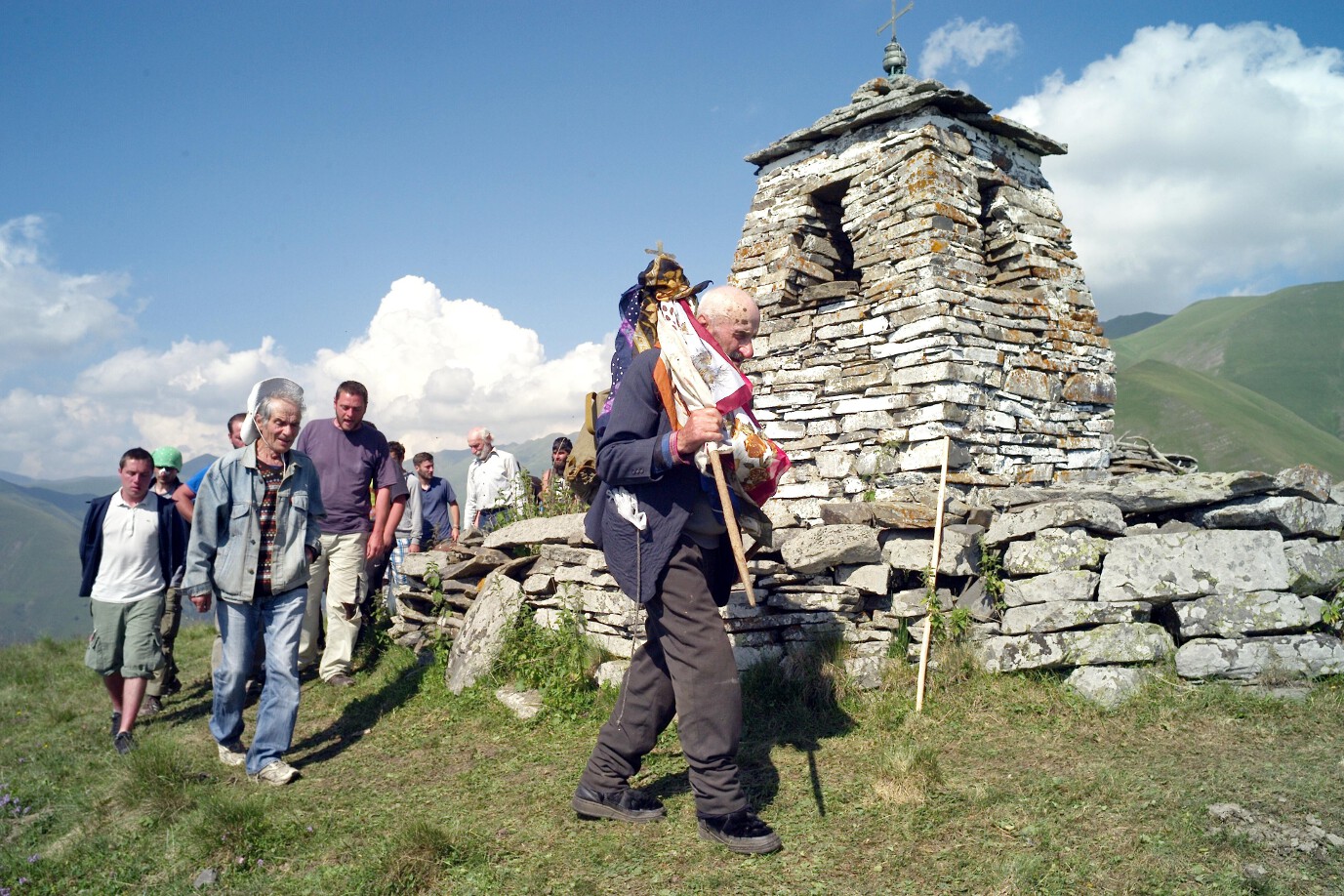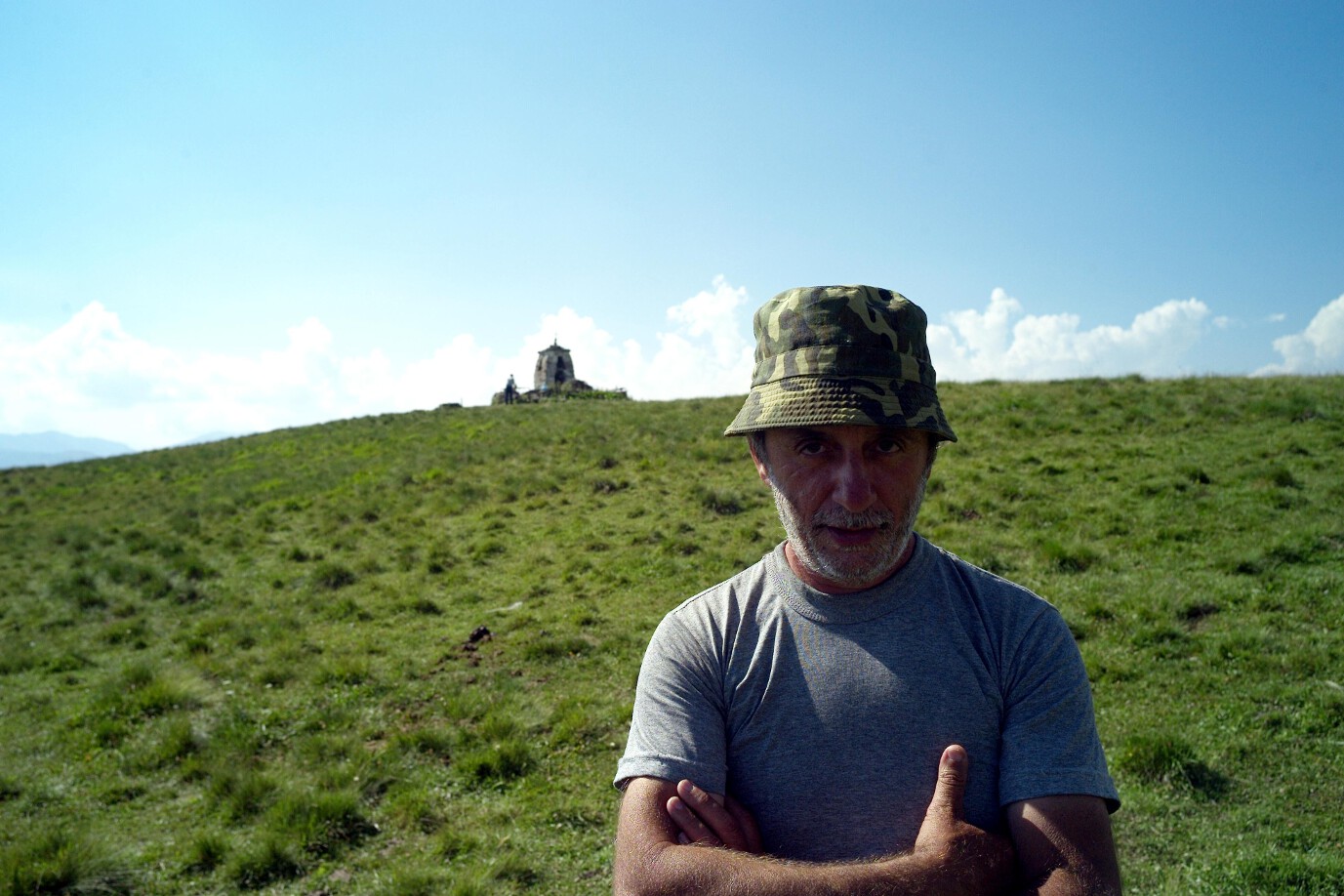The 2015 edition of the
SHRINE-FESTIVAL OF KOPALA
at
IREMTKALO
—
SACRED BEER AND HORSE RACING
AT A MOUNTAIN-TOP SHRINE IN PSHAVI
The following photographs were taken in 2015 during the Udzilaurta community's four-day "feast of Kopala". More specifically, they were taken during the rituals held before Kopala's mountain-top shrine at Iremtkalo (G. ირემთკალო, "the threshing-ground of the stag") on Saturday the 25th of July (the Saturday being the third day of the four-day festivity).
დიდება გმირს კოპალას ფშავ–ხევსურეთის საზღვარზე დაბრძანებულს, გაჭენებულ დარახტულ ცხენიანს, ლახტისა და მშვილდ–ისრის მომხმარესა, დევ–ეშმაკების მმუსრავსა!
A very interesting feature of this festival is that the shrine is shared between the members of the Pshav temi of Udzilaurta and those of the neighbouring Khevsur temi of Akusho. The mountain-top shrine is situated atop a relatively narrow ridge whose south-western slope belongs to Pshavi and whose north-western slope is part of Khevsureti:
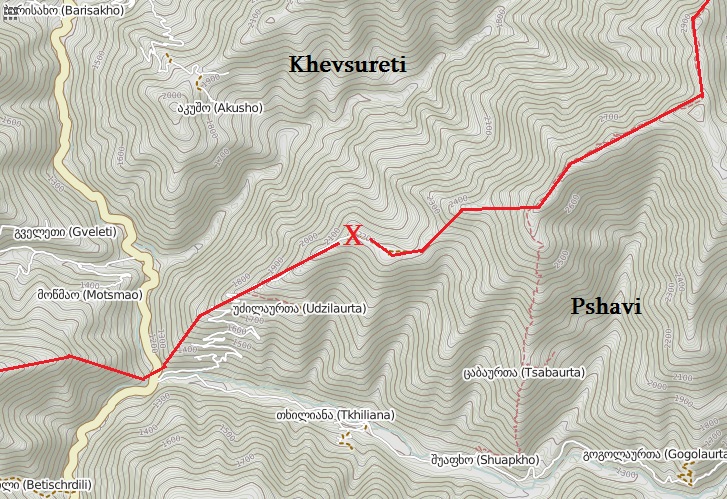
Iremtkalo is the place whence Kopala engaged in a boulder-throwing competition with the devs before slaying them (it was a trap), while his sworn brother Iakhsar slew many others:
Above the village of Udzilaurta there is an open space called Iremtkalo, from which Kopala and Iakhsar were challenged by the devs to compete with them by throwing enormous rocks towards Tsikhetgori and find out who was the strongest. Famous devs were summoned from all four corners to take part in the competition. Although Iakhsar and Kopala were to compete, the God-order-giver had ordered them to kill all the devs, so Iakhsar secretly made his way to a place called Saparavi Qeli on the Khashari mountain ridge to hide and lie in wait for the dev Muza who was making his way from Khashari to Iremtkalo. After killing Muza, he would climb down to Khashari and exterminate all the devs who lived there. Indeed, having climbed up from Khashari, Muza appeared on the mountain. Gazing towards Iremtkalo, he roared at Kopala and the other devs gathered there for the competition. At that very moment, Iakhsar revealed himself and hit the dev's head with his scourge and killed him on the spot. As he was dying, the mortally-wounded Muza roared so loud that even the other devs in Khashari heard him and sensed that Muza was in some kind of trouble. But before they could come to his aid, Iakhsar advanced with his scourge and rushed towards them and slaughtered every single dev in Khashari. He even crushed their homes, reducing them to ruins. Some devs managed to escape towards the Iori river, but Iakhsar followed them and killed them there. (Some say that the ruins of the devs' houses in Khashari are still visible, and that they were built of such enormous stones that even two men working together cannot move them.)
Here is the story of what was happening in the meantime in Iremtkalo: The devs and Kopala reinforced a threshing-floor-sized area with slates (this is the place where Kopala's bell-tower [still — A.B.] stands), for if they had started throwing the rocks without first strengthening the ground with slates, the ground would not have been able to support their weight and would have slid down the mountain. At first everyone waited for Iakhsar and Muza to arrive, but Kviria [a divinity second in importance only to God — A.B.] ordered them to start throwing the rocks. Kopala knew why Iakhsar and Muza had not showed up, but the idea never occurred to the devs for they thought none would even dare fight the powerful Muza. The devs' head wrestler [sic — A.B.] threw a rock, and it landed next to Tsikhetgori. Kopala was next. He used all his power to throw his rock further but Kviria nonetheless helped him by touching the rock with the tip of his whip, sending it further than the dev's. The devs then tried to throw the rock back to Iremtkalo, but could not even move it. (Some say that the even now the rock bears witness to their struggle; the rock shows signs of having been dragged back a little.) The frightened devs tried to flee, but Kopala used his power and his scourge and defeated them all. He also reduced their houses to ruins, carried off all their possessions, and settled there. His bell-tower still stands in Tsikhetgori. Pshav and Khevsur often visited [and still visit — A.B.] this place to pray during the Tsikhegoroba festival.
For more information on Kopala, an ogre-slaying demi-god of the Pshav-Khevsur pantheon (and, more specifically, the clanic deity of the Udzilaurta temi), please see this page, which reproduces a tale-cum-biography found in Shorena Kurtsikidze and Vakhtang Chikovani's amazing Ethnography and Folklore of the Georgia-Chechnya Border — Images, Customs, Myths & Folk Tales of the Peripheries (Munich: LINCOM EUROPA, 2008, pp. 273-283).
|
|
The "mountain-top annex" (Georgian: სამთო სალოცავი) of the Udzilaurta community's shrine to the demi-god Kopala stands at 2,250 metres above sea level above the mouth of the Pshavis Aragvi river. To the right, below the shrine, around 70 celebrants have camped out for the annual festival. |
|---|---|
|
|
Given the weight of what needs to be brought up to the shrine (small children, a tent, a sacrificial sheep, water and alcohol, firewood, sleeping bags, &c. &c.), many of the families drive up the long and sometimes terrifying mountain track in sturdy cars or on the back of six-wheel-drive Soviet-era lorries. |
|
|
The mountain-top shrine mainly consists of a c. 12-foot-high bell-tower surrounded by a low wall which only Ioseb Kochlishvili, the shrine's 89-year-old priest, may pass. |
|
|
The shrine priest supervises the four-day festivities, fulfilling all the ritual requirements (e.g. consecrating animals to be sacrificed, blessing the celebrants, lighting candles, saying prayers, &c;) and presiding over every ritual. For the first time in his 68-year career, this year the priest, now aged 89, did not climb the mountain to reach the shrine but rode up instead. |
|
|
Home-brewed beer is poured into various cups and bowls for the ritual of sakeino, when celebrants drink to the memory of past members of the community who died in battle abroad. |
|
|
The largest vessel is considered sacred and may therefore only be touched by the shrine priest, forcing those who attempt to drain it in one go to kneel on the ground before the shrine's sacred banner (G. დროშა, "flag"). |
|
|
Only men may approach the shrine. |
|
|
Horses and their riders gather to prepare for the traditional race which follows the sakeino ritual. |
|
|
|
|
|
|
|
|
The horses, a small but sure-footed Caucasian breed well suited to mountain life, are quite wild by European standards and their riders use neither saddles nor stirrups. Here, two stallions fight it out in the distance. |
|
|
In the foreground, the shrine priest's grandson, Rapiel Kochlishvili, before the race. |
|
|
One of the two other contestants makes the sign of the cross. Although a form of entertainment, the race is above all seen as a sacred ritual. (Interestingly, the rider in green did not finish the race.) |
|
|
Before the race, the riders and their steeds circle the shrine three times counter-clockwise. They then set off to another shrine (that of the Archangel—G. მთავარანგელოზი, "mtavarangelozi") before assembling at the starting line around a mile away. |
|
|
|
|
|
|
|
|
Rapiel Kochlishvili is the first to return to the shrine, thus winning the race, with second place close behind him and third place a good hundred yards back. One horse Did Not Finish. |
|
|
The shrine priest's grandson poses for a commemorative photograph of his victory. (He is indeed an consummate rider and deserved to win, yet the possibility that no other rider would have dared to beat him to victory out of respect for his grandfather and lineage lingers.) |
|
|
After the race, the riders once again circle the shrine three times, marking the end of the ritual. |
|
|
Having dismounted, they then drink a cup of beer each before the shrine. |
|
|
Some of the celebrants have been toasting the shrine all day and couldn't care less about the race. (Note the sheep, yet to be sacrificed, behind the lorry's rear axle.) |
|
|
In a ritual which marks the true end of this, the Iremtkalo stage of the four-day festival, the shrine priest leads a handful of celebrants around the shrine three times as they sing a traditional Pshav song. |
|
|
(N.B. Of the c. dozen men following the shrine priest, half were not local Pshavs at all—let alone members of the Udzilaurta community—but singers from Tbilisi. For a video recording of the procession and of the horse race, please see this Youtube page created by Dr Thomas Wier.) |
|
|
Local resident Dato Akriani (დათო აკრიანი), originally from the village of Martkopi SE of Tbilisi, has been living up here keeping bees and translating Orwell, Baudelaire and Maeterlinck for over 20 years. |
Unless stated otherwise or obviously not the case, all the text and images on this website are © A.J.T. Bainbridge 2006-2015
Do get in touch! Gmail: alexjtb

